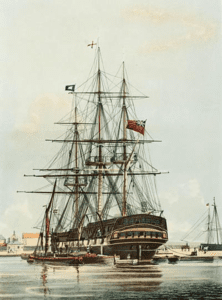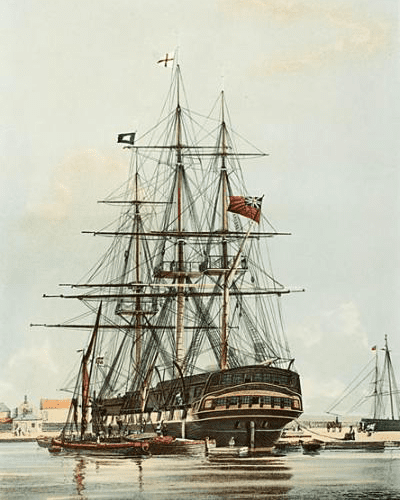
By the time George Simpson took command of the transport hospital ship, Arniston, in 1814, he was a 60-year-old, seasoned mariner. Arniston was owned by a company called Borradailes of London and had been requisitioned by the Royal Navy to bring invalided soldiers of the 73rd Regiment and some of their families back to England from Ceylon (modern day Sri Lanka).
Arniston was an East India merchant ship built on the Thames in 1794. Armed with 58 guns, it was 175 feet LOA, with a 43-foot beam, drawing 17 feet. On this voyage, Arniston would be homeward bound with 378 souls, including 14 women and 25 children.
The ship was not equipped with a marine chronometer, however, and Captain Simpson did not want to sail without one. Marine chronometers were being manufactured in England by the turn of the 19th century. They cost about £100, which at the time was equivalent to two years’ wages for a skilled workman. The marine chronometer allowed the solving of longitude, taking a great deal of guess work out of finding one’s position. The ship’s owners refused to purchase one and threatened to fire him if he didn’t depart. He was assured that other ships in the returning convoy would have chronometers.
Departing Ceylon, all was well until approaching the southern tip of Africa. A storm scattered the convoy and Simpson was on his own, beating to windward and bucking strong currents. Simpson misjudged his position, thinking that Cape Agulhas was the Cape of Good Hope. His position was to the east and north of his plotted position. Believing the ship had already rounded the southern cape, he set a northwesterly course for St. Helena. Too late he realized his error: He had run into the reefs of Cape Agulhas. He set three anchors to keep him off the reefs but the cables parted. Simpson tried to run the ship onto the beach. Arniston grounded on a reef and broke up. Only six survived — none of the women or children.
An officer from the same convoy reflected on the tragedy: “This valuable ship, and all the lives on board of her, were actually sacrificed to a piece of short-sighted economy. That they might have been saved had she been supplied with the worst chronometer that was ever sent to sea is also quite obvious.”
It wasn’t until 1825 and countless other maritime disasters before the Royal Navy finally began supplying its vessels with chronometers. Also, at the time of this grounding it was a misconception that the Cape of Good Hope was the most southern tip of Africa, when it is actually Cape Agulhas, 30 miles to the southeast.
Let us imagine we are with Captain Simpson, on May 26 and there is enough clear sky to take a noon sight. The DR is S 35° 20’ by E 21° 10’. Captain Simpson takes a noon sight of the lower limb from a height of 20 feet. Use a declination of the sun of N 21° 12’. The Hs of the sight is 33° 22.7’. Use the 2021 Nautical Almanac for this sight.
A. What is the Ho?
B. Establish the latitude.
Answers:
A. Ho 33° 33’.
B. Latitude is S 35° 15’

